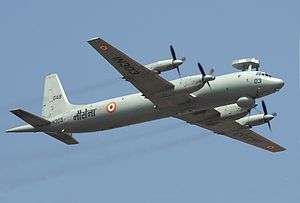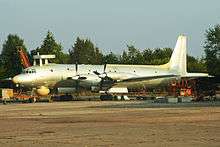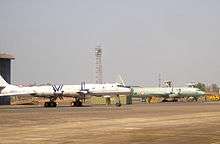Ilyushin Il-38
| Il-38 | |
|---|---|
 | |
| Ilyushin Il-38SD of the Indian Navy in 2007. | |
| Role | Anti-submarine warfare and maritime patrol aircraft |
| Design group | Ilyushin |
| First flight | 20 July 1971[1] |
| Primary users | Soviet Naval Aviation Russian Naval Aviation Indian Naval Air Arm |
| Number built | 58 |
| Developed from | Ilyushin Il-18 |
The Ilyushin Il-38 "Dolphin"[1] (NATO reporting name: May) is a maritime patrol aircraft and anti-submarine warfare aircraft designed in the Soviet Union. It was a development of the Ilyushin Il-18 turboprop transport.
Design and development
The Il-38 is an adaptation of the four-engined turboprop Ilyushin Il-18 for use as a maritime patrol aircraft for the Soviet Navy. It meets a requirement to counter American ballistic missile submarines. The Communist Party Central Committee and the Council of Ministers issued a joint directive on 18 June 1960, calling for a prototype to be ready for trials by the second quarter of 1962. The fuselage, wing, tail unit and engine nacelles were the same as the Il-18 and it had the same powerplant and flight deck. An aerodynamic prototype of the Il-38 first flew on 28 September 1961,[2] with the first production aircraft following in September 1967. Production continued until 1972, when the longer-range and more versatile Tupolev Tu-142 derivative of the Tupolev Tu-95 strategic bomber had entered service.[3]
The airframe is based on the Il-18, with the wings moved forward 3 m (9.84 ft).[4] Unlike the Il-18, only the forward fuselage of the Il-38 is pressurized. The tail contains a MAD, while under the forward fuselage a Berkut ("Golden Eagle") search radar (named "Wet Eye" by NATO) is housed in a bulged radome. There are two internal weapons bays, one forward of the wing, housing sonobuoys and one behind the wing housing weapons.[2]
Some Western sources state that 58 were produced;[3] the commander of the ASW squadron at Ostrov has stated that Soviet Naval Aviation received 35,[1] of which about thirty remain in service with Russian Naval Aviation.[5] Five were passed to India in 1977/8.[1] In the mid-1990s it seems the Tu-204/Tu-214 airliner won a competition against the Beriev A-40/Be-42 amphibious plane to replace the Il-38 in Russian service,[1] but a lack of funds crippled the project. More recently an A-40 variant seems to be under development to replace the Il-38.
India received three ex-Soviet Naval Aviation Il-38s in 1977, with two more arriving in 1983. Indian modifications included fitting pylons to the fuselage side to carry the Sea Eagle anti-ship missile.[6] The Il-38s of the Indian Navy have been sent back to Russia for upgrades. They will incorporate the new Sea Dragon avionic suite, incorporating a new radar, a Forward looking infrared (FLIR) turret under the nose and an electronic intelligence (ELINT) system housed in a box-like structure mounted on struts above the forward fuselage.[5] Three upgraded aircraft, designated Il-38 SD, have been delivered to the Indian Navy.[7] There are reports of efforts towards adding the capability to fire the Indo-Russian Brahmos cruise missile from this aircraft. Mockups have been displayed with air-launched Brahmos attached to underwing pylons on the Indian Navy aircraft.
Operational history
One prototype was lost in the early 1970s when it was forced to ditch in the sea.[1]
The Il-38 was operated by units in the Soviet Northern, Pacific and Baltic fleets. In March 1968 a squadron of Il-38s deployed to Cairo in Egypt, flown by Soviet crews but in Egyptian markings, until being withdrawn in 1972. Il-38s continued to deploy overseas through the Cold War, flying from Aden in South Yemen, Asmara in what was then Ethiopia, Libya and Syria. Two Il-38s were attacked on the ground in a commando raid and at least one was destroyed by Eritrean People's Liberation Front fighters in 1984 at Asmara.[3] Following the end of the Cold War and the breakup of the Soviet Union, Il-38s continue in service with the Russian Navy's Arctic and Pacific Fleets.[5]
The type made its first visit to a NATO base in 1995, at NAS Jacksonville.[1] Its first appearance at an airshow in the West was at the 1996 Royal International Air Tattoo in the UK.[1]
A tragic midair crash occurred on 1 October 2002, during the Indian squadron's silver jubilee celebrations. IN302 and IN304, which were flying parallel to each other, had a midair collision above the Dabolim airport in Goa. All twelve aircrew (six aboard each aircraft) were killed and both aircraft were also destroyed.[8]
On December 7, 2010, two Russian Navy Il-38s appeared over the Japan Sea near the Noto Peninsula, interrupting a combined US-Japan Navy drill. The exercises were temporarily halted because of concern that Il-38s might be carrying out surveillance missions on US/Japan naval activities.
Variants

- Il-38
- Production aircraft
- Il-38M
- Modified variant with a receiver probe as part of a hose and drogue air refuelling System, did not enter service
- Il-38MZ
- Was a modified tanker variant of the Il-38, did not enter service
- Il-38N
- Improved variant sometimes referred to as Il-38SD for Sea Dragon the new search and tracking system. Version for the Russian Navy is equipped with the Novella system.[9] Il-38N is able to find air targets at ranges of up to 90 kilometers and follow the surface objects within a radius of 320 kilometers. 7 aircraft have been delivered to the Russian Navy[10] Modernized anti-submarine planes have entered into service with Russia’s Pacific Fleet.[11]
Operators

Specifications (Il-38)
Data from Russian Navy at RIAT 1996[1]
General characteristics
- Crew: seven-eight[1]
- Length: 40.185[1] m (131 ft 10 in)
- Wingspan: 37.4[1] m (122 ft 8 in)
- Height: 10.17[1] m (33 ft 4 in)
- Wing area: 140[1] m2 (1,500 sq ft)
- Empty weight: 35,500[1] kg (78,264 lb)
- Max takeoff weight: 66,000[1] kg (145,505 lb)
- Powerplant: 4 × Ivchencko/Progress AI-20M[1] turboprop engines, 3,151 kW (4,225[1] hp) each
Performance
- Maximum speed: 645[1] km/h (401 mph; 348 kn)
- Ferry range: 7,500[1] km (4,660 mi; 4,050 nmi)
- Endurance: 13 hours[1]
- Service ceiling: 11,000[1] m (36,089 ft)
- Rate of climb: 5.33 m/s (1,049 ft/min)
Armament
- 20,000 lb (9,000 kg) of disposable stores, including depth-charges, mines, torpedoes and bombs.
See also
- Related development
- Aircraft of comparable role, configuration and era
References
| Wikimedia Commons has media related to Ilyushin Il-38. |
- 1 2 3 4 5 6 7 8 9 10 11 12 13 14 15 16 17 18 19 20 21 22 Borst, Marco P.J. (Summer 1996). "Ilyushin IL-38 May- the Russian Orion" (pdf). Airborne Log. Lockheed: 8–9.
- 1 2 Lake 2005, p.31.
- 1 2 3 Lake 2005, p.32.
- ↑ Gordon 2004, p.92.
- 1 2 3 Lake 2005, p.36.
- ↑ Lake 2005, pp.32-33.
- ↑ http://lenta.ru/news/2010/02/19/il38sd/
- ↑ India navy planes collide in mid-air
- ↑ http://lenta.ru/news/2012/03/05/il38n/
- ↑ http://bmpd.livejournal.com/2241950.html
- ↑ http://sputniknews.com/military/20150923/1027429782.html#ixzz3mvps17Pn
- Lake, Jon. "Russia's Submarine Killer: Ilyushin IL-38 May". Air International, February 2005, Vol 68 No.2. Stamford, UK:Key Publishing. pp. 30–36.
- Gordon, Yefim and Dmitriy Komissarov, Ilyushin Il-18/-20/-22; A Versatile Turboprop Transport, Midland Publishing:Hinckley England. 2004.